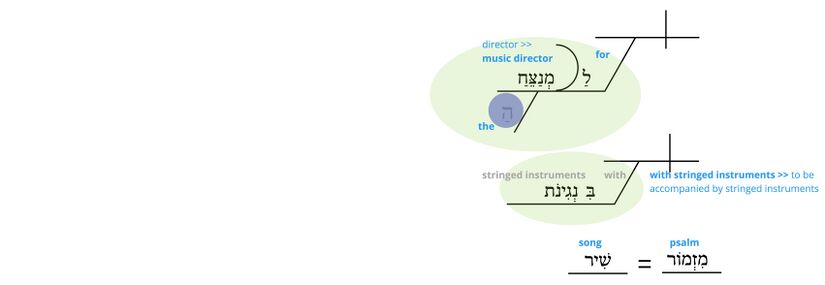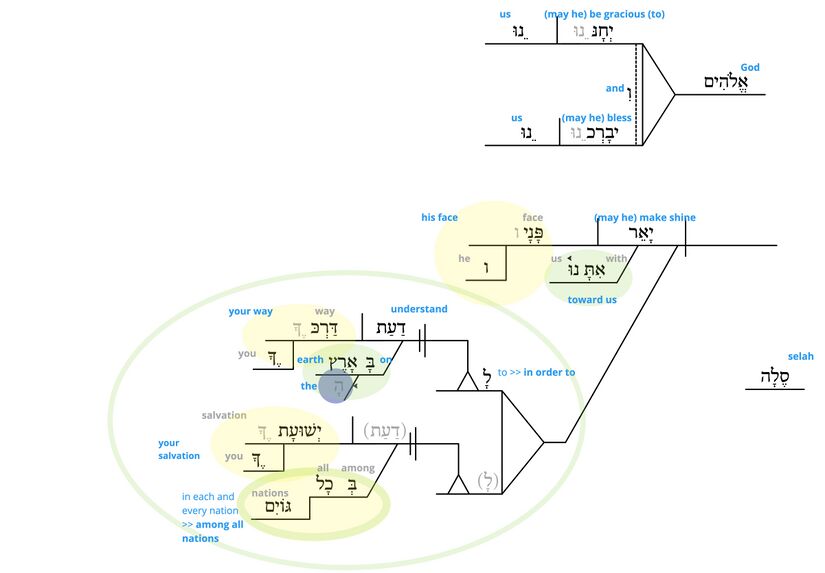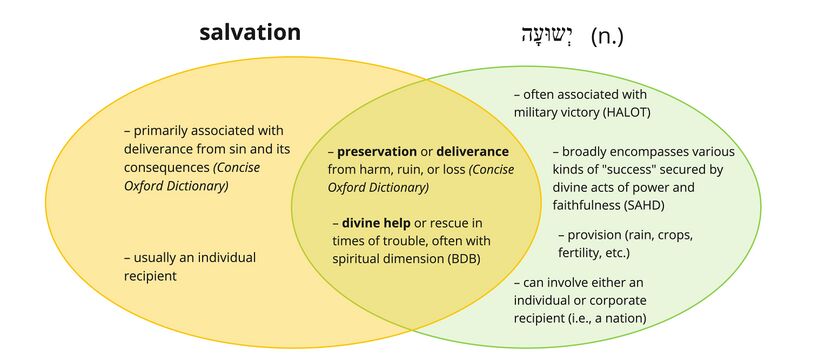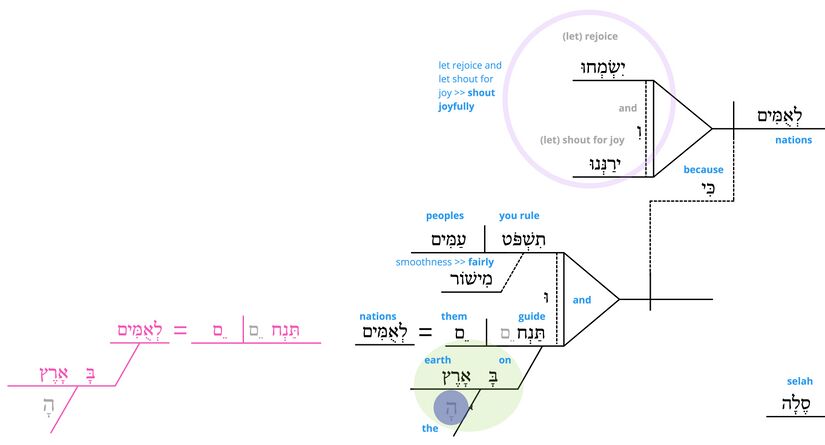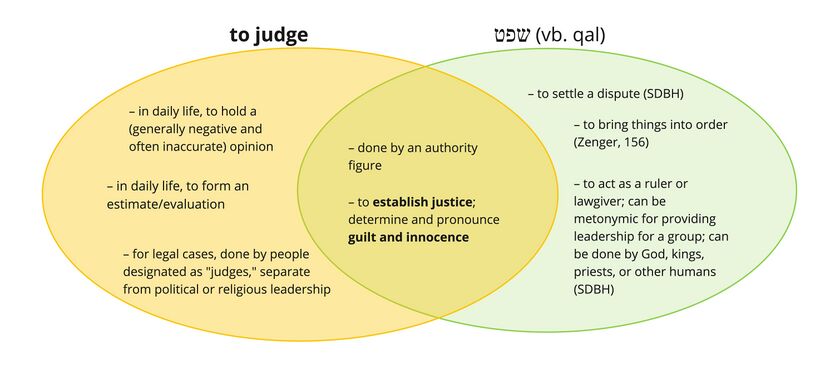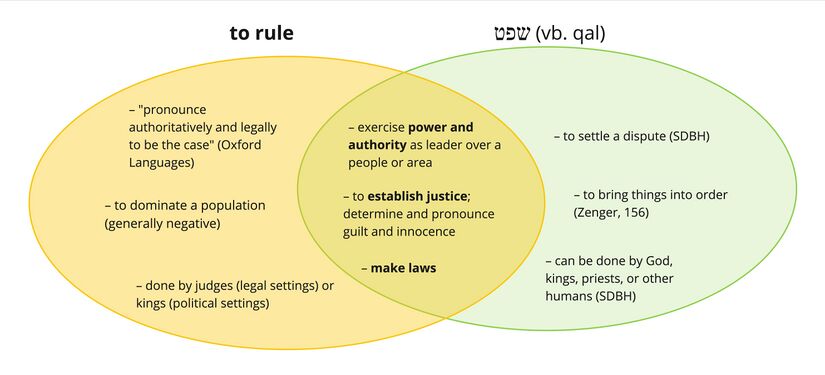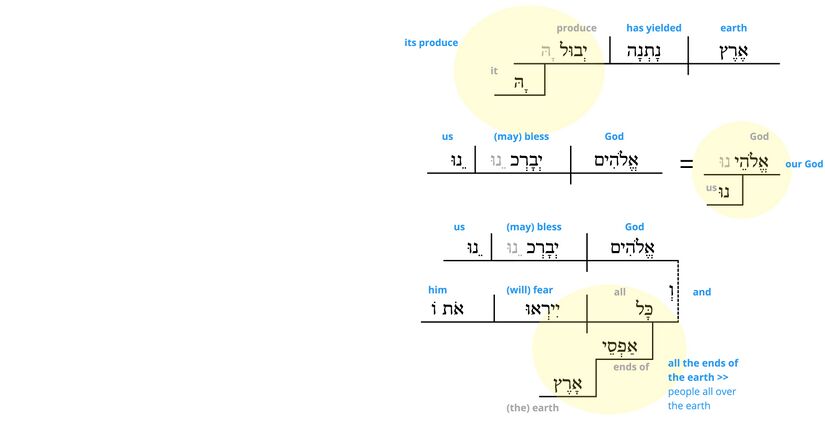Psalm 67 Verse-by-Verse: Difference between revisions
No edit summary |
No edit summary |
||
| Line 155: | Line 155: | ||
* | * | ||
====Notes on Verse 8==== | ====Notes on Verse 8==== | ||
* | *Verse 8 brings the poem full circle by juxtaposing Israel directly with the nations: 8a speaks of God blessing '''us''', while 8b speaks of '''the ends of the earth''', representing the nations. As each additional nation comes to know God and experience his blessing, the circle of “us” grows wider and wider, finally stretching to the ends of the earth. See [NEED LINK] Poetic Feature #2 for more details. | ||
*The grammar of 8b<ref>beginning with a waw + yiqtol verb</ref> clarifies its function as a purpose clause for 8a. This relationship between the lines reinforces the relationship already established by verses 2 and 3; God blesses that others may come to know him. | |||
*To '''fear''' God (ירא) is to revere him, to have respect and awe for him.<ref>SDBH</ref> People come to revere someone as they get to know someone’s character and acts. In other words, knowing and fearing often come together<ref>The two verbs “know” (ידע) and fear” (ירא) are often found together in Scripture (e.g., Proverbs 1:7, 1:29, 2:5, 9:10, and Isaiah 11:2, 33:6).</ref> This psalm makes it clear that there are currently people who do not know God well enough to be in awe of him, but when they do get to know him (vv. 2-3 and 5), they will revere him (v. 8), and praise him (vv. 4-6). Notice from the poetic line structure how verses 3 and 8 are connected poetically, with an inverted shape of 3/2 and 2/3 words per line, respectively [NEED PIC]: This poetic connection seems to reinforce the connections between the two verses of (1) know/fear and (2) the mention of the earth as representative of the people on the earth.<ref>See Poetic Feature #3 for more details on the use of the word “earth” in this psalm.</ref> | |||
*The idiom '''ends of the earth''' (אַפְסֵי־אָֽרֶץ) is figurative of the groups of people living all over the earth,<ref>Although “earth” (ארץ) lacks a definite article, we can deduce from the context that the referent here is "the whole earth"; see also BHRG (§24.4.1), "a common noun that has acquired the value of a proper noun." In other words, this appearance of the word is grammatically indefinite but semantically definite.</ref>, even to its extremities. Nations are equated elsewhere with the ends of the earth (Deut 33:17), both as a far antecedent (Psalm 59:9,14) and in parallel (Psalm 2:8, Psalm 22:28).<ref> God is of course no stranger to the people at the ends of the earth. He created the ends of the earth (Proverbs 30:4), he has the power to judge them (1 Samuel 2:10), and he can communicate with them (Psalm 59:9,14). He has promised them to his son (Psalm 2:8); his king will rule over them (Psalm 72:8). Other psalms bring out the willingness of their allegiance to him as they get to know him through his deeds (Psalm 22:28-29; Psalm 65:9; and Psalm 98:3).</ref> “To Israel, just as to Babylon (8) and Egypt (33 and 34), it is self-evident that it inhabits the center of the earth, while other nations dwell at earth’s edges”<ref>Keel ''Symbolism of the Biblical World: Ancient Near Eastern Iconography and the Book of Psalms'' (page 38). Keel also says, “''’ps'' means “end” in the sense of cessation, discontinuation of existence. The ''’psy ’rs'' are found at that point beyond which no habitable land exists” (42).</ref>--but see Poetic Feature #2 [NEED LINK] for a twist on how this ethno-centric orientation is treated in Psalm 67! | |||
=Legends= | =Legends= | ||
Revision as of 16:33, 25 May 2023
Back to Psalm 67 overview page.
Welcome to the DRAFT Verse-by-Verse Notes for Psalm 67!
The Verse-by-Verse Notes present scholarly, exegetical materials (from all layers of analysis) in a verse-by-verse format. They often present alternative interpretive options and justification for a preferred interpretation. The Verse-by-Verse Notes are aimed at consultant-level users.
The discussion of each verse of this psalm includes the following items.
- A link to the part of the overview video where the verse in question is discussed.
- The verse in Hebrew and English.[1]
- An expanded paraphrase of the verse.[2]
- A grammatical diagram of the verse, which includes glosses for each word and phrase.[3]
- A series of notes on the verse, which contain information pertaining to the interpretation of the psalm (e.g., meaning of words and phrases, poetic features, difficult grammatical constructions, etc.).
Note: This page is under construction! Search for [NEED LINK] for links that need to be added after other pieces of the psalm are posted.
v. 1
Watch the Overview video on v. 1.
| v. | Hebrew | Close-but-clear |
|---|---|---|
| 1 | לַמְנַצֵּ֥ח בִּנְגִינֹ֗ת מִזְמ֥וֹר שִֽׁיר׃ | For the music director. With stringed instruments. A psalm, a song. |
Expanded Paraphrase
Grammatical Diagram
Notes
vv. 2-3
Watch the Overview video on vv. 2-3.
| v. | Hebrew | Close-but-clear |
|---|---|---|
| 2a | אֱלֹהִ֗ים יְחָנֵּ֥נוּ וִֽיבָרְכֵ֑נוּ | May God be gracious to us and may he bless us. |
| 2b | יָ֤אֵ֥ר פָּנָ֖יו אִתָּ֣נוּ סֶֽלָה׃ | May he shine his face toward us -- Selah |
| 3a | לָדַ֣עַת בָּאָ֣רֶץ דַּרְכֶּ֑ךָ | -- in order to understand your way on earth, |
| 3b | בְּכָל־גּ֝וֹיִ֗ם יְשׁוּעָתֶֽךָ׃ | your salvation among all nations. |
Expanded Paraphrase
Grammatical Diagram
Notes on Verse 2
- This opening verse of the psalm draws closely on the Aaronic blessing (Numbers 6), with some slight differences. See the [NEED LINK] Surprise! Poetic Feature for more details. This combination of verbs and expressions would likely have called up priestly settings for the original hearers.
- The Covenant God of Israel (YHWH) is intended by "God" (Elohim) in this psalm.
- Although not all the verbs in this verse are morphologically jussive, we take our cue from "shine" and the connections with the Aaronic prayer to consider them all with jussive force. The result is the language of request.[4] The verbs of Psalm 67 are discussed more fully under the Verbal Semantics of Psalm 67 exegetical discussion.[5]
- "Bless" serves as a very broad term that encompasses every aspect of life. Deuteronomy 28 outlines many of the blessings available to Israel in the covenant; Tate (1998) gives an overview of different categories that may have been included.[6]
- The term "be gracious to" (חנן) can also mean to show favor, to be "kindly disposed" or "generous."[7]
- To "shine" is "associated with well-being and wisdom."[8] God's face shining is associated throughout Scripture with his favor.[9]
- The use of "toward" for the preposition אִתָּ֣נוּ helpfully brings out the component of relationship, the sense of affection brought out by SDBH. Another option could be "upon."[10] In any case, the construction used here in Psalm 67 seems to match the meaning of the preposition אל used in Numbers 6:25-26.
Notes on Verse 3
- Verse 3 shifts from language of the Aaronic blessing, as found in verse 2, to language of the Abrahamic blessing, not only in semantic content,[11] but also in the use of the 2nd-person pronominal suffix.[12] See the [NEED LINK] Surprise! Poetic Feature for more details.
- The prefix ל opening the verse is one of purpose, "in order.” The subject may be understood as “those on earth.” See The Grammar and Meaning of Ps. 67:3 for a more extensive discussion of the intricacies of this verse. Note that the infinitive לָדַ֣עַת ‘to understand’ has been elided in the second clause of verse 3, but applies to both clauses.
- Earth here refers to the whole world. It is possible the word also suggests a double entendre with the land of Israel. In fact, it's likely that the author has encoded some intentional ambiguity here, since the blessing on "our land" will be turned into blessing for the whole earth. See [NEED LINK] the What on Earth? Poetic Feature for more insights into the word ‘earth’ as used throughout Psalm 67.
- Note the unconventional word order in both 3a and 3b, where the prepositional phrase appears before the object. A similar word order appears in 5c, where the prepositional phrase appears before the verb.
- God’s way may be understood as his characteristic activity (e.g., Psalm 103:7) and his mighty acts.[13] God often “makes known” his way to Israel (e.g., Exodus 18:20, when he gives the Torah; Exodus 33:13, where Moses asks God to teach him his way; Jeremiah 5:4, where Israel is accused of not knowing God’s way). Here he makes it known not only to Israel but also to the nations! It was known that foreigners would be drawn to him when they heard about his deeds (e.g., 1 Kings 8:41-43).
- God’s salvation represents security, including protection, success, and deliverance[14], suggesting that those under his care will not come into harm, ruin, or loss.[15] The Venn diagram below shows the differences and overlap between one possible American English understanding of the term and our best understanding of the original Hebrew meaning:
- Applied to a plural and indefinite noun, all (כֹּל) here might also be phrased ‘each and every one.’[16] The choice of the indefinite seems to suggest that the Hebrews felt they did not know who all the nations were and wanted to use a term that would encompass every possibility, no exceptions.
- See the notes on verse 4 for a discussion of nations (גּ֝וֹיִ֗ם) and other “people group” words.
v. 4
Watch the Overview video on v. 4.
| v. | Hebrew | Close-but-clear |
|---|---|---|
| 4a | יוֹד֖וּךָ עַמִּ֥ים ׀ אֱלֹהִ֑ים | Let the peoples praise you, God, |
| 4b | י֝וֹד֗וּךָ עַמִּ֥ים כֻּלָּֽם׃ | let the peoples praise you, all of them. |
Expanded Paraphrase
Grammatical Diagram
Notes
- The two lines of this verse are nearly identical, suggesting a rhetorical function of repetition in order to provide emphasis, as this sentiment is stated 4 times total in the psalm (two times here in verse 4, and another two times in verse 6).
- All three words used in this psalm for peoples or nations (גּוֺיִם in v. 3; עַמִּים in vv. 4-5-6; לְאֻמִּים in v. 5) refer to groups of people "united by common descent, religion, or language."[17] All can be personified. See the Venn diagram below for a comparison of the three terms. As a brief summary:
- לְאֹם is somewhat archaic, the least common, and is only found in poetry; only once does it refer exclusively to Israel
- the other two terms can refer to Israel or to the non-Israelite nations, but very often refer to the non-Israelite nations when used in plural
- עַם seems the most generic but also has the strongest connections with religious covenant associations and kinship relationships
- The term praise may be defined as an "action by which humans openly express recognition of what someone else has done or achieved."[18] God's mighty deeds are connected with praise in multiple places in the psalms (e.g., 106:2, 145:4, and 150:2) but also in the Torah (Deut 3:24 and 10:21). As mentioned in verse 3 above, foreigners are going to be drawn to Israel because of God's reputation (lit. his name) and his ability to accomplish might deeds (1 Kings 8:41-43).
v. 5
Watch the Overview video on v. 5.
| v. | Hebrew | Close-but-clear |
|---|---|---|
| 5a | יִֽשְׂמְח֥וּ וִֽירַנְּנ֗וּ לְאֻ֫מִּ֥ים | Let the nations shout joyfully, |
| 5b | כִּֽי־תִשְׁפֹּ֣ט עַמִּ֣ים מִישׁ֑וֹר | because you rule the peoples fairly, |
| 5c | וּלְאֻמִּ֓ים ׀ בָּאָ֖רֶץ תַּנְחֵ֣ם סֶֽלָה׃ | and the nations you guide on the earth. Selah. |
Expanded Paraphrase
Grammatical Diagram
Notes
- The only tricolon in the poem, verse 5 serves as the center to the strong chiastic structure of Psalm 67, as shown in the visual below:
[NEED PICTURE OF POETIC STRUCTURE] Notice how the words for “peoples” and “nations” move from last to first position over the course of the verse.[19] Remarkably, the central word of the whole poem falls in the center of the middle line, “peoples” (עַמִּ֣ים)—see the Center and Periphery Poetic Feature [NEED LINK] for more details.
- The two verbs in 5a function as an auxiliary verb construction: the first verb (joy) acts as an adverb modifying the second verb (“ringing cry”[20] or “shout”[21]). These verbs appear in collocation elsewhere, though often in the reverse order. See Zephaniah 3:14, Zechariah 2:14, and Psalms 5:12, 32:11, 35:27, 90:14, and 92:5.[22]
- The word rule comes from a Hebrew root often rendered ‘to judge’ (שָׁפַט). In Psalm 67, both 5b and 5c seem to be referring to God’s kingship over the nations (cf. Ps. 96). As king, his role, far beyond simply establishing justice (i.e., determining guilt and innocence), would also include exercising power and authority, including making laws. See the two Venn diagrams below for a comparison of the concepts of ‘judge' and 'rule' in English:
- The grammatical structure of 5c is ambiguous: Are the nations of the earth being guided, or is God guiding them on the earth? The latter seems most likely…. [WAITING FOR HELP ON THIS FROM ELIZABETH, OOBIE, and IAN.]
- The word guide suggests both leading and sustaining, like a shepherd (cf. Psalm 23:3), with wise and effective leadership. See the Venn diagram below.
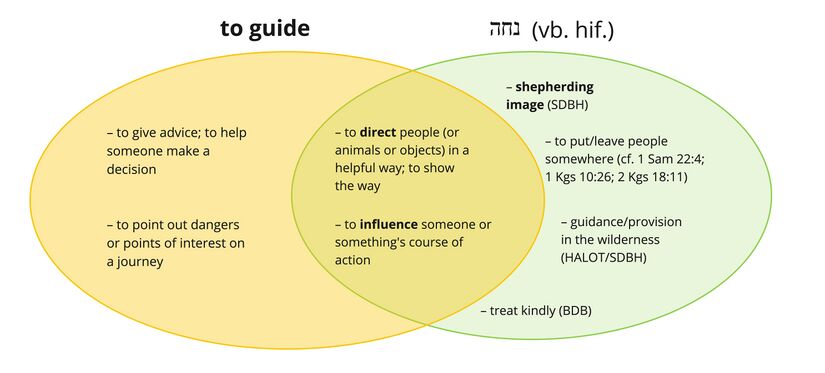 This verb may call up connections with the Exodus--God will lead each nation of the earth as he did the Israelites out of Egypt and through the wilderness.[23] They can depend on him for each move and for all provision along the way.[24]
This verb may call up connections with the Exodus--God will lead each nation of the earth as he did the Israelites out of Egypt and through the wilderness.[23] They can depend on him for each move and for all provision along the way.[24]
v. 6
Watch the Overview video on v. 6.
| v. | Hebrew | Close-but-clear |
|---|---|---|
| 6a | יוֹד֖וּךָ עַמִּ֥ים ׀ אֱלֹהִ֑ים | Let the peoples praise you, God, |
| 6b | י֝וֹד֗וּךָ עַמִּ֥ים כֻּלָּֽם׃ | let the peoples praise you, all of them. |
Expanded Paraphrase
Grammatical Diagram
Notes
- Verse 6 is identical to verse 4, completing the strong chiastic center of this poem. Please see verse 4 for more details.
vv. 7-8
Watch the Overview video on vv. 7-8.
| v. | Hebrew | Close-but-clear |
|---|---|---|
| 7a | אֶ֭רֶץ נָתְנָ֣ה יְבוּלָ֑הּ | The earth has yielded its produce. |
| 7b | יְ֝בָרְכֵ֗נוּ אֱלֹהִ֥ים אֱלֹהֵֽינוּ׃ | May God, our God, bless us. |
| 8a | יְבָרְכֵ֥נוּ אֱלֹהִ֑ים | May God bless us |
| 8b | וְיִֽירְא֥וּ אֹ֝ת֗וֹ כָּל־אַפְסֵי־אָֽרֶץ׃ | so that all the ends of the earth will fear him. |
Expanded Paraphrase
Grammatical Diagram
Notes on Verse 7
- A number of linguistic features seem to highlight 7a in this poem,[25] suggesting some type of emphasis, while the reference to produce unlocks a probable context for this psalm of people bringing their firstfruits to God (see the Psalm 67 Story behind the Psalm for more details).[26]
- The word produce (יְבוּלָ֑הּ) is always used for agriculture (crops) in the Old Testament. There may be, however, a metaphorical play on words happening here with the “produce” also suggesting the praise of the nations (vv. 4-6)—nations represented by the first (v. 3) and final (v. 8) mentions of “earth.”
- It is to be understood that God gives fertility, rain, and protection of the growing crops so that the earth produces a harvest. In other words, the crops indicate God’s blessing as requested at the beginning of the poem.[27] Encouraged by this tangible evidence that God has already blessed them, the speakers of the poem reiterate their request in 7b; they have good reason to ask him to continue blessing them![28] In addition, poetically 7a is in chiastic relationship with 3b (see the diagram under the first verse 5 note above), connecting earth’s produce with God’s salvation (provision/care) for people. Given the ambiguity of the subject of verse 3, this produce probably indicates not only the blessing given to Israel, which the nations see, but also the same blessing given to the nations, one that they come to recognise as they come to understand God’s leadership (verse 5).
- The verbs in 7b (and 8a), as opposite in clear chiasm with the jussives of vv. 2-3, may also be taken as jussive. As noted above, the verbs of Psalm 67 are discussed more fully under the Verbal Semantics of Psalm 67 exegetical discussion.
Notes on Verse 8
- Verse 8 brings the poem full circle by juxtaposing Israel directly with the nations: 8a speaks of God blessing us, while 8b speaks of the ends of the earth, representing the nations. As each additional nation comes to know God and experience his blessing, the circle of “us” grows wider and wider, finally stretching to the ends of the earth. See [NEED LINK] Poetic Feature #2 for more details.
- The grammar of 8b[29] clarifies its function as a purpose clause for 8a. This relationship between the lines reinforces the relationship already established by verses 2 and 3; God blesses that others may come to know him.
- To fear God (ירא) is to revere him, to have respect and awe for him.[30] People come to revere someone as they get to know someone’s character and acts. In other words, knowing and fearing often come together[31] This psalm makes it clear that there are currently people who do not know God well enough to be in awe of him, but when they do get to know him (vv. 2-3 and 5), they will revere him (v. 8), and praise him (vv. 4-6). Notice from the poetic line structure how verses 3 and 8 are connected poetically, with an inverted shape of 3/2 and 2/3 words per line, respectively [NEED PIC]: This poetic connection seems to reinforce the connections between the two verses of (1) know/fear and (2) the mention of the earth as representative of the people on the earth.[32]
- The idiom ends of the earth (אַפְסֵי־אָֽרֶץ) is figurative of the groups of people living all over the earth,[33], even to its extremities. Nations are equated elsewhere with the ends of the earth (Deut 33:17), both as a far antecedent (Psalm 59:9,14) and in parallel (Psalm 2:8, Psalm 22:28).[34] “To Israel, just as to Babylon (8) and Egypt (33 and 34), it is self-evident that it inhabits the center of the earth, while other nations dwell at earth’s edges”[35]--but see Poetic Feature #2 [NEED LINK] for a twist on how this ethno-centric orientation is treated in Psalm 67!
Legends
Grammatical diagram
| Visualization | Description |
|---|---|
| The clause is represented by a horizontal line with a vertical line crossing through it, separating the subject and the verb. | |
| The object is indicated by a vertical line that does not cross the horizontal line of the clause. Infinitives and participles may also have objects. If the direct object marker (d.o.m.) is present in the text, it appears in the diagram immediately before the object. If the grammar includes a secondary object, the secondary object will appear after the object, separated by another vertical line that does not cross the horizontal line of the clause. | |
| The subject complement follows the verb (often omitted in Hebrew) separated with a line leaning toward the right. It can be a noun, a whole prepositional phrase or an adjective. The later two appear modifying the complement slot. | |
| When a noun further describes or renames the object, it is an object complement. The object complement follows the object separated by a line leaning toward the right. | |
| In a construct chain, the noun in the absolute form modifies the noun in the construct form. | |
| Participles are indicated in whatever position in the clause they are in with a curved line before the participle. Participles can occur as nominal, where they take the place of a noun, predicate, where they take the place of a verb, or attributive, where they modify a noun or a verb similar to adjectives or adverbs. | |
| Infinitives are indicated by two parallel lines before the infinitive that cross the horizontal line. Infinitive constructs can appear as the verb in an embedded clause. Infinitive absolutes typically appear as an adverbial. | |
| The subject of the infinitive often appears in construct to it. In this situation, the infinitive and subject are diagrammed as a construct chain. | |
| The object of the infinitive is indicated by a vertical line that does not cross the horizontal line of the infinitival clause. | |
| Modifiers are represented by a solid diagonal line from the word they modify. They can attach to verbs, adjectives, or nouns. If modifying a verb or adjective, it is an adverb, but if modifying a noun, it is an adjective, a quantifier, or a definite article. If an adverb is modifying a modifier, it is connected to the modifier by a small dashed horizontal line. | |
| Adverbials are indicated by a dashed diagonal line extending to a horizontal line. These are nouns or infinitives that function adverbially (modifying either a verb or a participle), but are not connected by a preposition. | |
| Prepositional phrases are indicated by a solid diagonal line extending to a horizontal line. The preposition is to the left of the diagonal line and the dependent of the preposition is on the horizontal line. They can modify verbs (adverbial) or nouns (adjectival). | |
| Embedded clauses are indicated by a "stand" that looks like an upside-down Y. The stand rests in the grammatical position that the clause fulfills. Extending from the top of the stand is a horizontal line for the clause. If introduced by a complementizer, for example כִּי, the complementizer appears before the stand. Embedded clauses can stand in the place of any noun. | |
| When clauses are joined by a conjunction, they are compound clauses. These clauses are connected by a vertical dotted line. The conjunction is placed next to the dotted line. | |
| Within a clause, if two or more parts of speech are compound, these are represented by angled lines reaching to the two compound elements connected by a solid vertical line. If a conjunction is used, the conjunction appears to the left of the vertical line. Almost all parts of speech can be compound. | |
| Subordinate clauses are indicated by a dashed line coming from the line dividing the subject from the predicate in the independent clause and leading to the horizontal line of the subordinate clause. The subordinating conjunction appears next to the dashed line. | |
| Relative clauses also have a dashed line, but the line connects the antecedent to the horizontal line of the relative clause. The relative particle appears next to the dashed line. | |
| Sentence fragments are represented by a horizontal line with no vertical lines. They are most frequently used in superscriptions to psalms. They are visually similar to discourse particles and vocatives, but most often consist of a noun phrase (that does not refer to a person or people group) or a prepositional phrase. | |
| In the body of the psalm, a horizontal line by itself (with no modifiers or vertical lines) can indicate either a discourse particle or a vocative (if the word is a noun referring to a person or people group). A discourse particle is a conjunction or particle that functions at the discourse level, not at the grammatical level. Vocatives can appear either before or after the clause addressed to them, depending on the word order of the Hebrew. | |
| Apposition is indicated by an equal sign equating the two noun phrases. This can occur with a noun in any function in a sentence. |
| Hebrew text colors | |
|---|---|
| Default preferred text | The default preferred reading is represented by a black line. The text of the MT is represented in bold black text. |
| Dispreferred reading | The dispreferred reading is an alternative interpretation of the grammar, represented by a pink line. The text of the MT is represented in bold pink text, while emendations and revocalizations retain their corresponding colors (see below). |
| Emended text | Emended text, text in which the consonants differ from the consonants of the Masoretic text, is represented by bold blue text, whether that reading is preferred or dispreferred. |
| Revocalized text | Revocalized text, text in which only the vowels differ from the vowels of the Masoretic text, is represented by bold purple text, whether that reading is preferred or dispreferred. |
| (Supplied elided element) | Any element that is elided in the Hebrew text is represented by bold gray text in parentheses. |
| ( ) | The position of a non-supplied elided element is represented by empty black parentheses. For example, this would be used in the place of the noun when an adjective functions substantivally or in the place of the antecedent when a relative clause has an implied antecedent. |
| Gloss text colors | |
|---|---|
| Gloss used in the CBC | The gloss used in the Close-but-Clear translation is represented by bold blue text. |
| Literal gloss >> derived meaning | A gloss that shows the more literal meaning as well as the derived figurative meaning is represented in blue text with arrows pointing towards the more figurative meaning. The gloss used in the CBC will be bolded. |
| Supplied elided element | The gloss for a supplied elided element is represented in bold gray text. |
Shapes and colours on grammatical diagram
| Visualization | Description |
|---|---|
| The prepositional phrase is indicated by a solid green oval. | |
| The construct chain is indicated by a solid yellow oval. | |
| When the conjunction ו appears at the phrase-level (not clause-level), it is indicated by a solid light purple oval. | |
| The article is indicated by a solid blue oval. |
Expanded paraphrase
(For more information, click "Expanded Paraphrase Legend" below.)
References
- ↑ The Hebrew text comes from Open Scriptures Hebrew Bible, which presents the text of the Leningrad Codex (the Masoretic text). The English text is our own "Close-but-clear" translation (CBC). The CBC is a “wooden” translation that exists to provide a window into the Hebrew text. It is essentially an interlinear that has been put into English word-order. It is also similar to a “back-translation” (of the Hebrew) often used in Bible translation checking. It is important to remember that the CBC is not intended to be a stand-alone translation, but is rather a tool for using the Layer by Layer materials. The CBC is used as the primary display text (along with the Hebrew) for most analytical visualisations. It is also used as the display text for most videos.
- ↑ A legend for the expanded paraphrase is available near the bottom of this page, in the section titled "Legends."
- ↑ Legends for both the grammatical diagram and the shapes and colours on the grammatical diagram are available near the bottom of this page, in the section titled "Legends."
- ↑ In speech-act terms, this means that declarative sentences have directive force, a pattern that repeats often throughout the poem. The speakers are requesting God to bless them so that the nations will praise and fear him. See more under the [NEED LINK] Speech Act Analysis for this psalm.
- ↑ Psalm 67: Looking Back, Looking Forward, or Both provides a view of how the verbs operate in the big picture of the psalm.
- ↑ "The blessing of God manifests itself in different ways, but it is especially the intensification of life in such ways as to empower growth, fertility, and prosperity (Deut 7:13; 28:3–6). The blessing of God consists in his ongoing presence in life, his sustaining of the well-being of the world, and his providing family (Ps 128), food (Ps 132:15), dew (Ps 133:3), rain (Hos 6:3), etc. A. A. Anderson (478, on 66:20) remarks, “In a sense God’s blessing was not an independent force, but rather the active help of God himself, so that one could not have the blessing without the giver.” The presence of God comes with his blessing" (157). In another place, he adds: "The blessing of God takes diverse forms: posterity (Gen 26:23; 28:3), prosperity and wealth (Gen 24:35; Deut. 7:12–13), land (Gen 35:12; 48:3), the removal of the curse from the ground (Gen 8:21–2), fertility, health, and victory (Deut 7:14–16)" (Tate 1998, 158, emphasis added).
- ↑ SDBH
- ↑ SDBH
- ↑ "The shining forth of the face of God among his people is a metaphor for his goodwill and blessing (cf. Pss 4:7; 31:17; 44:4; 80:4, 8, 20; 89:16; 119:135). A shining, bright face reveals a person of good disposition and is a sign of inward pleasure. “In the light of a king’s face there is life,/ and his favor is like the clouds that bring the spring rain” (Prov 16:15, RSV). The opposite of God’s shining face is his hidden face. When God hides his face, the life of his people is endangered (cf. Pss 10:1; 13:2; 30:8; 44:25; 104:29; Deut 31:18)" (Tate 1998, 157).
- ↑ Waltke & O'Connor (11.2.4a #7) specifically suggest "toward us" for this passage, as the "complement of verbs of dealing, speaking, and making."
- ↑ The first iteration of this promise, in Genesis 12:1-3, contains many overlapping terms with Psalm 67:3, while other statements of this promise (Genesis 18:18, 22:18, and Genesis 26:4) use “all nations (goy) of the earth (eretz),” thereby increasing the connections with this verse.
- ↑ Genesis 12:1-3 is full of 2nd-person pronominal suffixes as the Lord speaks to Abraham; verse of Psalm 67 suddenly shifts into 2nd person with two pronominal suffixes as Abraham's descendants speak directly to Him.
- ↑ Brown, Seeing the Psalms 2002:43
- ↑ SDBH
- ↑ Concise Oxford Dictionary
- ↑ כָל־גּ֝וֹיִ֗ם presents an unidentifiable whole (all the nations) composed of individual items (each nation).
- ↑ SDBH
- ↑ SDBH
- ↑ Using a device known as poetic enclosure, lines b and c feature a a-bc // bc-a’ mirror structure.
- ↑ Strong’s; BDB
- ↑ SDBH
- ↑ Other translations that represent the two verbs as one verbal unit include: “Let the nations celebrate with joyful songs” (CEV); "Let the whole world sing for joy” (NLT); “Que las naciones griten de alegría” (DHH); “Sie sollen vor Glück und Freude singen” (GNB); "Nations rejoice in glad song" (Robert Alter’s 2018 The Hebrew Bible: A Translation with Commentary.
- ↑ NIDOTTE 3.76 and Futato 2009, 223
- ↑ Perhaps on some level God is guiding the peoples into the Land, referring to a new Exodus, a connection for the nations back to the land of Israel. See, for example, the nations coming to Israel in Isaiah 2:2-4 and Zechariah 14:16-19. See the What on Earth? Poetic Feature [NEED LINK] for more on the importance of the word ‘land’ (אֶרֶץ) in this poem.
- ↑ Unusual linguistic features of 7a: the only qatal verb of the poem; sentence (thetic) focus, as suggested by an indefinite and fronted subject, with the function of starting a new section; the rare word for produce (יְבוּל), occurring only 13x in the OT; introducing the new sense of soil/agriculture for “earth” (NEED LINK; see Poetic Feature #3 for more details); a prominent change in speech act (from directive to assertive); and the only sentence without a mismatch between the sentence type and the illocution type (see the NEED LINK OR PIC Speech Act Analysis for Psalm 67 for more details).
- ↑ The Israelites would have brought their crops to the Temple corporately at least 2x per year: The Feast of Firstfruits noted in Leviticus 23:9-14 would have fallen during the Feast of Unleavened Bread at the time of Passover, while the Feast of Weeks was designated in Exodus 34:22 as the time to bring the firstfruits of the wheat harvest. It seems the Israelite version of bringing firstfruits greatly redeems a heavy-handed tradition in other parts of the ANE. The “Instructions to Priests and Temple Officials” in the Context of Scripture (1.83) provides insight into the threats if people did not bring their firstfruits.
- ↑ The land giving produce is directly connected with God’s blessing elsewhere in Scripture, such as in Psalm 85:12, Deuteronomy 7:13 and 28:1-14, and Malachi 3:10-12.
- ↑ Thetic sentences such as 7a can function as grounds for the following clause.
- ↑ beginning with a waw + yiqtol verb
- ↑ SDBH
- ↑ The two verbs “know” (ידע) and fear” (ירא) are often found together in Scripture (e.g., Proverbs 1:7, 1:29, 2:5, 9:10, and Isaiah 11:2, 33:6).
- ↑ See Poetic Feature #3 for more details on the use of the word “earth” in this psalm.
- ↑ Although “earth” (ארץ) lacks a definite article, we can deduce from the context that the referent here is "the whole earth"; see also BHRG (§24.4.1), "a common noun that has acquired the value of a proper noun." In other words, this appearance of the word is grammatically indefinite but semantically definite.
- ↑ God is of course no stranger to the people at the ends of the earth. He created the ends of the earth (Proverbs 30:4), he has the power to judge them (1 Samuel 2:10), and he can communicate with them (Psalm 59:9,14). He has promised them to his son (Psalm 2:8); his king will rule over them (Psalm 72:8). Other psalms bring out the willingness of their allegiance to him as they get to know him through his deeds (Psalm 22:28-29; Psalm 65:9; and Psalm 98:3).
- ↑ Keel Symbolism of the Biblical World: Ancient Near Eastern Iconography and the Book of Psalms (page 38). Keel also says, “’ps means “end” in the sense of cessation, discontinuation of existence. The ’psy ’rs are found at that point beyond which no habitable land exists” (42).
